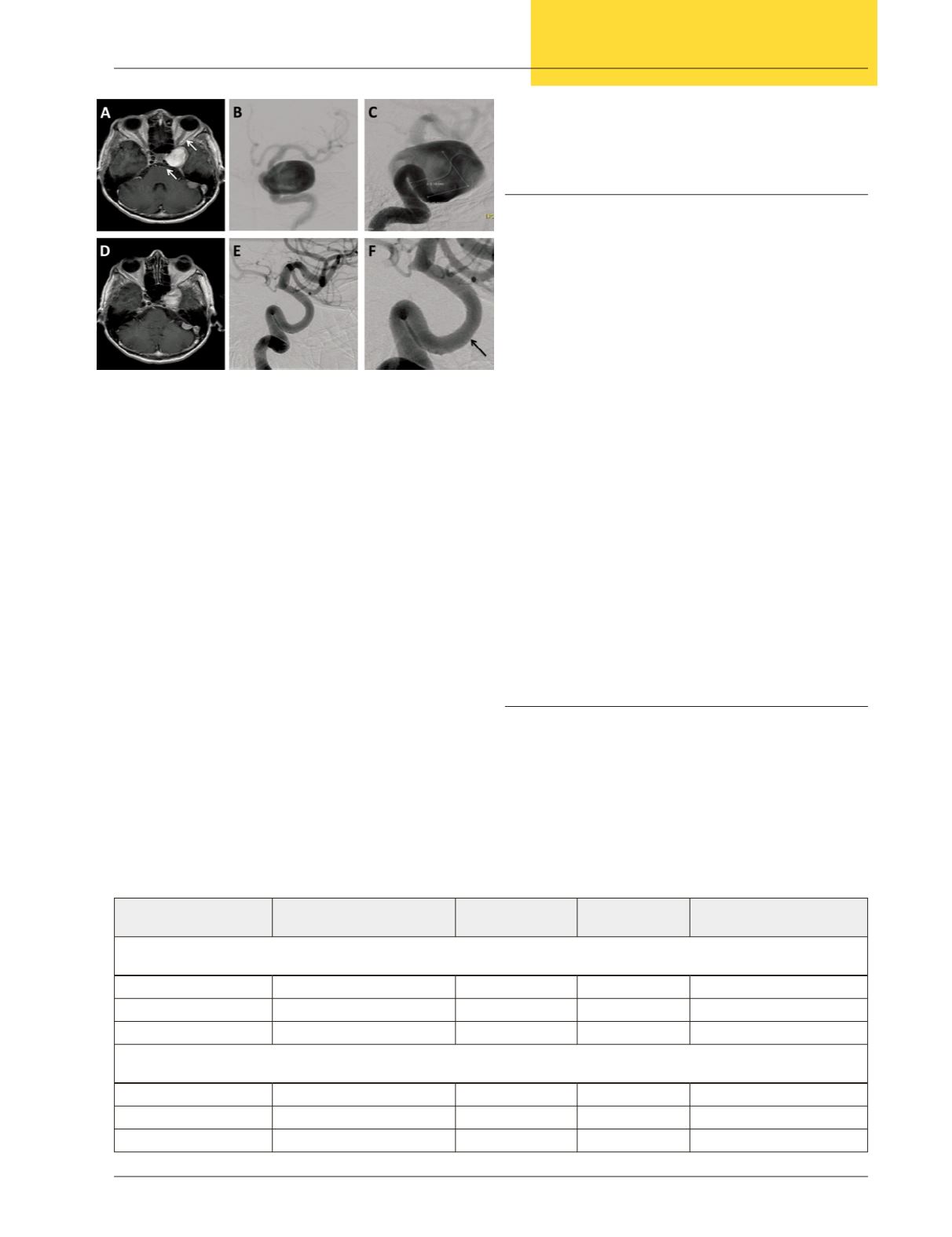
Northeast Florida Medicine
Vol. 66, No. 3 2015
31
Endovascular Neurosurgery
occlusion alone to techniques that incorporated intravascular
stents, not only to support aneurysm occlusion, but also to
achieve reconstruction of the diseased vessel (Table 4).
Flow Diversion
The principle of flow diversion is a relatively new ap-
proach.
14
With this technique, thediseasedparent artery giving
rise to the aneurysm is reconstructed through the implantation
of a flow diverter between two healthy segments of the artery.
Flow diverters are stent-like devices that provide higher metal
surface area coverage compared to intracranial stents, and were
designed to disrupt the inflow jet inside the aneurysmand redi-
rect blood flow along the parent artery (Figure 6). This creates
an environment that is conducive to aneurysm thrombosis
and shrinkage. In addition, flow diverters provide a scaffold
for neo-endothelialization to permanently seal the neck of the
aneurysmandprovide long-lasting aneurysmocclusion (Figure
7). A wave of innovation resulted in several different types of
flow diverters such as the Surpass, SILK and FRED. As of
mid-2015, the Pipeline Embolization Device (PED; Covidien
Vascular, Mansfield, MA, USA) remains the only flow diverter
approved by the Food and Drug Administration (FDA). Still,
this technology is not without caveats. After implantation of
flow-diverters, dual-antiplatelet therapy is mandatory and
continued for at least three months, leaving this technology
unattractive for ruptured aneurysms. Bifurcation aneurysms
are also not candidates for treatment with flow-diverters due
to inherent design limitations. Recent studies have warned
against the use of multiple telescoping devices due to the risk
of occlusion of perforator arteries and stroke.
15
Intrasaccular Devices
Thelimitationsofendoluminalflow-divertershavestimulated
the development of a new type of embolization device. These
newdevices are self-expanding ovoid or cylindrical braided im-
plantsthat,whendeployedintotheaneurysmcavity,producean
attenuatedmeshofmetal across theneck/parent artery interface
Figure 7:
This clinical case illustrates an unruptured aneurysm
treated with a flow diverter. T1-weighted axial MRI after contrast
(A) demonstrates a giant aneurysm (30 mm) extending from
the cavernous portion of the internal carotid artery. The lesion is
causing significant mass effect. Note displacement of the ipsilateral
optic nerve and neurovascular structures (white arrows). Diagnostic
angiogram on AP (B) and lateral (C) views confirmed the presence
and location of the aneurysm with significant inflow of contrast
into the lesion. The aneurysm was treated using the Pipeline
Embolization Device, which was deployed in the internal carotid
artery and covered completely the neck of the aneurysm. Follow-
up MRI with contrast approximately 3 months after treatment
demonstrated significant decrease in aneurysm size and mass
effect (D). Follow-up diagnostic angiogram on lateral view (E)
showed remarkable remodeling of the internal carotid artery
and complete occlusion of the aneurysm. A magnified lateral
view of the diagnostic angiogram (F) shows the exact location
where the aneurysm was located (black arrow). Before the era of
flow diverters, similar lesions were not considered candidates for
endovascular treatment and microsurgery would have entailed a
significant risk of major neurological morbidity or death.
Table 4.
Morbidity and Mortality of Aneurysm Treatment in Large Studies
Treatment modality
Study
Number
of patients
Duration
of follow-up
Combined rate of
morbidity & mortality
Stent-assisted coiling
Neuroform
Fiorella et at (2010)
16
284
13 months
8.1%
Neuroform/Enterprise
Piotin et at (2010)
17
216
14 months
13.4%
Neuroform/Enterprise/LEO Shapiro et al (2012)
18
1517
13 months
5.3%
Flow-diversion
Pipeline
PUFS Trial (2013)
19
107
12 months
5.6%
Pipeline/Silk
Brinjikji et al (2013)
20
1651
6 months
9%
Pipeline
IntrePED Registry (2015)
21
793
19.3 months
8.3%


